MAC's Believe It Or Not!
Reprinted from "Crown Jewels of the Wire", August 1991, page 12
WESTERN REGION FINDS
I'm sure many of you were wondering what happened to Mac and his column. Then
there were probably many of you who hadn't noticed I'd been gone. Well, for all
of you, I'm back! And I do mean back, Believe It Or Not!!
June brought two trips to the Western Region; the first was to Arizona
(strictly a pleasure trip), and the second was to San Luis Obispo for the
Western Regional Show.
The Arizona trip was designed for R and R (that's rest and
relaxation, not R. Good Jr. and RDP), but Carol and I enjoy contacting insulator
collectors no matter where we are around the country (or the world for that
matter). Our one and only find in Arizona was one of the great names in early
insulator collecting. Those of you who attended the 1975 National may remember
the name -- John Woodard of Sedona, Arizona. My recollections of John at San Diego were of a gentleman with some spectacular insulators for sale (CD
140.5 cobalt blob, CD 130.1 cobalt Cal, CD 130.2 Seilers, etc.) Most of these
pieces were new to me at the time, as the trip to the San Diego National was our
first insulator show west of the Mississippi. And the prices! An insulator
selling for $1,000 was unbelievable to me, a rather common occurrence by today's
standards.
Carol and I had a chance to spend a pleasant evening with Mr. Woodard
and learned, among other things, that he was "getting out" of
insulators in 1975, that he currently owns three insulators (two Brooke's
ramshorns and a Brookfield pony), and that in spite of the fact that he has
spent much of his adult life in Sedona, he is getting ready to move because
there are "just too many people in Sedona now" (I think it's grown to
a 9,000 population). John has many fond memories of insulator collecting and
says hello to all his insulator friends.
One of the truly great things about our hobby is the unending list of new
finds and/or new information that turns up. Here's just a sampling of items from
the San Luis Obispo Regional Show.
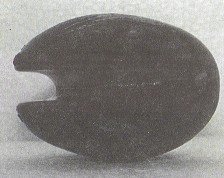
1. A large nearly mint California egg in purple picked (yes, Believe It Or
Not, removed from service. as part of a repair call) within the past six weeks!
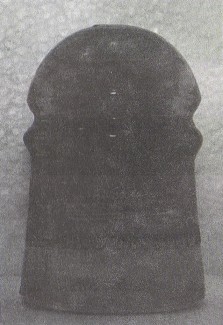
2. A CD 102 Brookfield with a metal insert in the pinhole which was threaded
on the exterior to be screwed into the insulator and smooth on the internal
surface. Those of us who looked at it agreed that it appeared to be an insert
designed to hold a threaded insulator on a threadless pin. If someone has
another explanation for this insert, please drop Mac a note. (The picture above is not clear enough to show the insert clearly.)
3. Once again, I was approached to authenticate a CD 111 Pyrex. Interest in
that piece has increased dramatically due to its reported rarity. Last fall, we
sent a hopeful collector's specimen of what he thought was a CD 111 to Mr. N.R.
Woodward to ask his opinion of the potential CD 111. The answer to last fall's
question appears in "Ask Woody" column in this issue. Keep bringing in
those examples. We may turn up a CD 111 yet.
4. Some of you may have wondered what happened to the old CD 154.7 in Volume
2 of Insulators-A History and Guide to North American Glass Pintype
Insulators.
This CD was never assigned to an insulator by N.R. Woodward, so it was excluded from the listings. Hopefully, the picture on the
next page will clear up the mystery.
As with many other CD's, CD 154.5 covers a
range of shapes. The picture shows what I would call the two extremes of CD
154.5. On the left is what I believe is the former CD 154.7. It is unembossed
with round drips in a beautiful yellow green. The piece seems to be a mold
variation of embossed Derflinger insulators. Thanks to Dwayne Anthony for sharing that
piece and Mike Guthrie for providing the comparison.
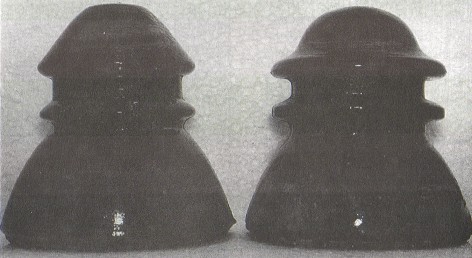
5. Occasionally a new glass look-alike turns up in porcelain. Bill Rohde
showed me a beauty pictured below. The brown glazed power piece is a dead ringer for CD 283 No.1 Provo. (Once again, I apologize that I have no
comparison picture. They wouldn't fit in my light box together.)
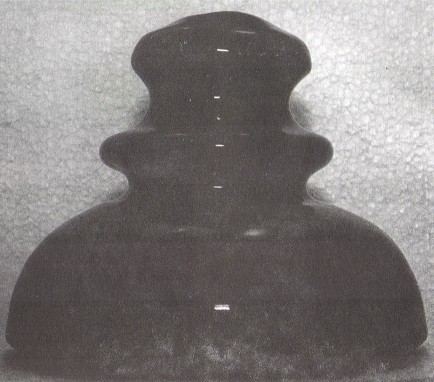
6. This listing is for all of you embossing buffs. The last listing in the
190/191 Hemingray section shows a hyphen at the bottom of the embossing between
"HEMINGRAY" and "50" (i.e. HEMINGRAY _50) (See the picture
below) The listing also indicates blotted out embossing on the back. Paul
Greaves helped me break the code on this one. "HEMINGRAY" is centered
in the mold half and the"__50" has been added, leaving the total
embossing off center. "MADE IN U.S.A." is embossed on the back over
blotted out "No 50". Hence, this listing results from a reworked mold
that used to say (F-Skirt) HEMINGRAY (R-Skirt) No 50. End of mystery, Believe It Or
Not!
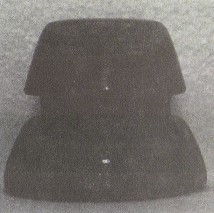
THE LOCKE STORY
Fred M. Locke is one of the great names in insulator history. Two really neat
things happened at the San Luis Obispo show that may help un-Locke (excuse the
pun) more of the Fred M. Locke history. First let me introduce you to Barbara
Locke Dellard and her husband Bill. That's right, Believe It Or Not, LOCKE! She
is the granddaughter of Fred M. himself.
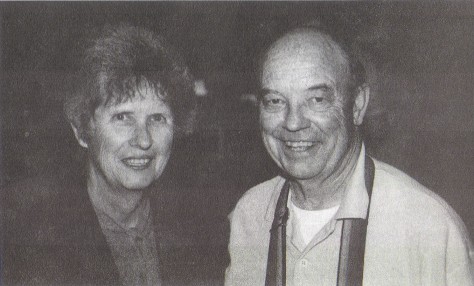
Barbara Locke Dellard and husband Bill of Paso Robles, California
In the time we had to talk, a few of the
many wonderful stories about Mr. Locke came out. I'll save them for another
article, but suffice it to say that we were all very excited to meet a blood
relative of one of our pioneers. Mr. and Mrs. Dellard were fascinated by the
continuing interest in the insulator business. Maybe we'll get 'em hooked. Don't
worry, there'll be more about the Dellard's and Mr. Locke later.
If meeting the
Dellards wasn't enough, Jim Wattell walked in with a little brown bag with a
real gem in it. Pictured below at first glance is a cup and saucer (I should
have taken a picture from higher up to give you more of the cup and saucer look)
and an after dinner aperitif. But, lo and behold, when you turn them upside-down
and stack them together, you have a replica of a three piece power insulator.
The lettering leaves no doubt as to its source. It was picked up at a garage
sale, but the former owners knew nothing of its origin. Maybe it was a party
favor at the Locke Company Christmas party! Believe It Or Not!
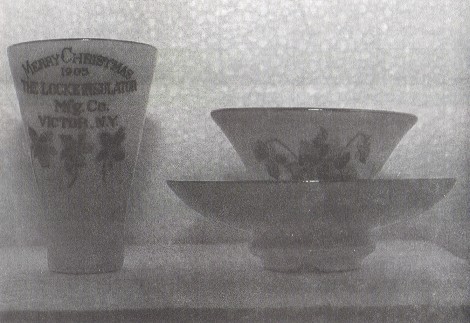
The aperitif (left) and cup and saucer (right) Both are hand painted
china
with violets. Printing on the aperitif reads:
MERRY CHRISTMAS
1905
THE LOCKE
INSULATOR
Mfg. Co.
VICTOR, N.Y.
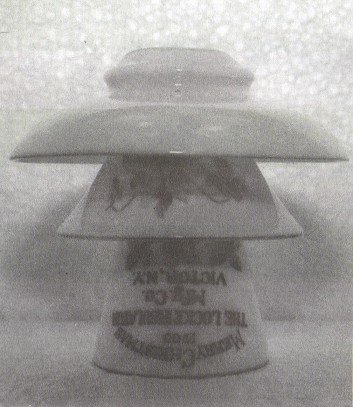
Put the aperitif upside down, follow it with the cup upside down,
and finally
turn the saucer upside down and you have
a Locke multipart insulator!
| 